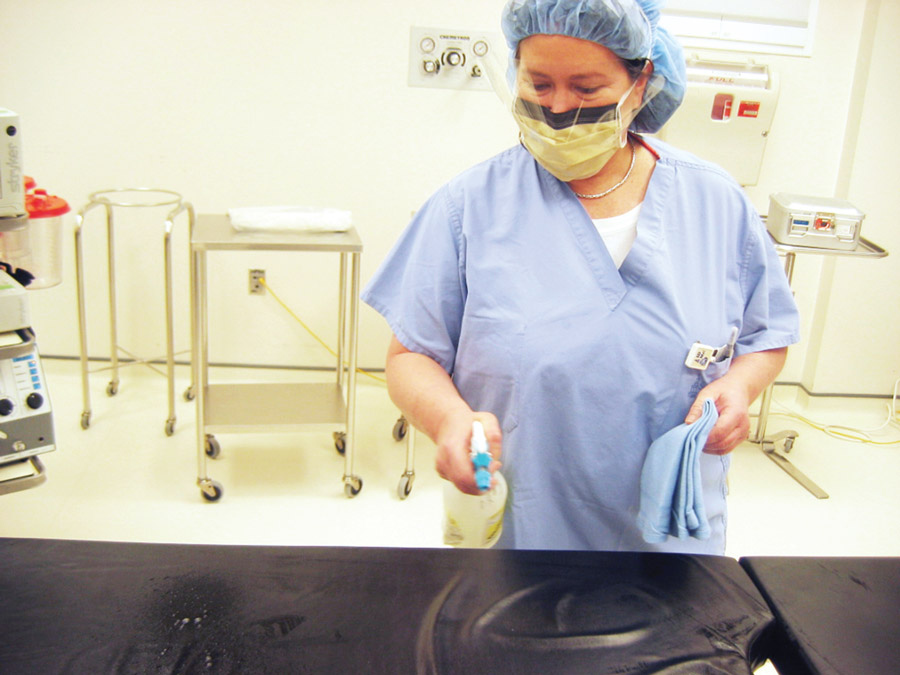With public health experts sounding the alarm about the likelihood of a second COVID-19 spike this winter in the midst of flu season, whole room disinfection technologies are becoming more appealing because manual cleaning alone simply isn't an effective enough way to fully clean and disinfect the OR. "Studies have shown that about 50% of surfaces in hospitals that need to be cleaned are not," says Luci Perri, RN, BSN, MSN, MPH, CIC, FAPIC, CSPDT, the owner and president of Infection Control Results, a consulting company located in Charlotte, N.C. "If the surfaces are not properly cleaned and disinfected, you have a greater likelihood of a healthcare worker picking up organisms off the surface and potentially transferring them to a patient."
The reasons for a lack of adequate surface disinfection range from a variability in cleaning tactics among environmental services staff to historically high turnover in those positions, says Ms. Perri. Of course, in many smaller, free-standing ASCs, nursing staff clean ORs between cases. The expanded safety protocols stemming from the pandemic have stretched staff thin, making it more difficult for them to follow proper surface disinfection and cleaning protocols.
That's where mobile ultraviolet-C (UV-C) devices and hydrogen peroxide vapor (HPV) systems come in. These systems can eliminate an array of bacteria, viruses (such as COVID-19) and fungi, including multidrug-resistant organisms. Both of these options have their advantages and their disadvantages, according to Ms. Perri. Let's look at the pros and cons of each.
- UV-C devices. Mobile UV-C devices are wheeled into an OR and emit short-frequency UV-C light that effectively breaks up the bacterial DNA in that space. UV-C devices take much less time to disinfect than HPV systems — approximately 15 to 25 minutes per area. However, they only kill contaminants within a direct line of site of the UV light beam, points out Ms. Perri. "They may be quick, but you have to move the device two to three times to disinfect a typical OR," she adds.
Still, the devices are effective and can be used in a variety of ways. For instance, St. Charles Health System in Bend, Ore., acquired three UV-C devices that have been used to reduce the cases of hospital-acquired infections from C. diff., disinfect a surgical instrument sterilization room following a sewage pipe burst and disinfect emergency room areas during a flu outbreak. The facility also employs a UV-C device to disinfect ORs used for total joint replacements, sterilize a cardiac cath lab and spot clean other areas of its facilities.
"The greatest benefit of the device is being able to kill spores in the areas that you can't reach to clean," says Rochelle "Rockie" Shatka, CHESP, environmental services manager at St. Charles Health. After the environmental services staff completes a thorough manual cleaning of rooms, they run the UV-C machine — purchased for around $100,000 — through a cleaning cycle, which takes 45 minutes to complete, according to Ms. Shatka.
You may think incorporating whole-room disinfection into a well-established workflow process would take some getting used to, but Ms. Shatka says the process was pretty seamless. "We just incorporated it as part of our standard cleaning process," says Ms. Shatka.
- Hydrogen peroxide vapor. These systems produce airborne hydrogen peroxide in the form of a vapor or mist, which covers every surface of the enclosed space in which they are located and are used for terminal cleanings of ORs. They take longer to run than UV-C systems — in some cases a lot longer. The time factor could be outweighed by the overall effectiveness of the system, however. "It appears that hydrogen peroxide generally has a more effective kill rate," says Ms. Perri.
For safety reasons, both UV-C and HPV systems require staff to close and stay out of the room while the devices are in use. However, because hydrogen peroxide is extremely toxic to humans, the HPV safety requirements go a step further. "You have to seal the room off completely, close all HVAC vents and monitor the room to make sure vapor isn't escaping," she says.
.svg?sfvrsn=be606e78_3)

.svg?sfvrsn=56b2f850_5)